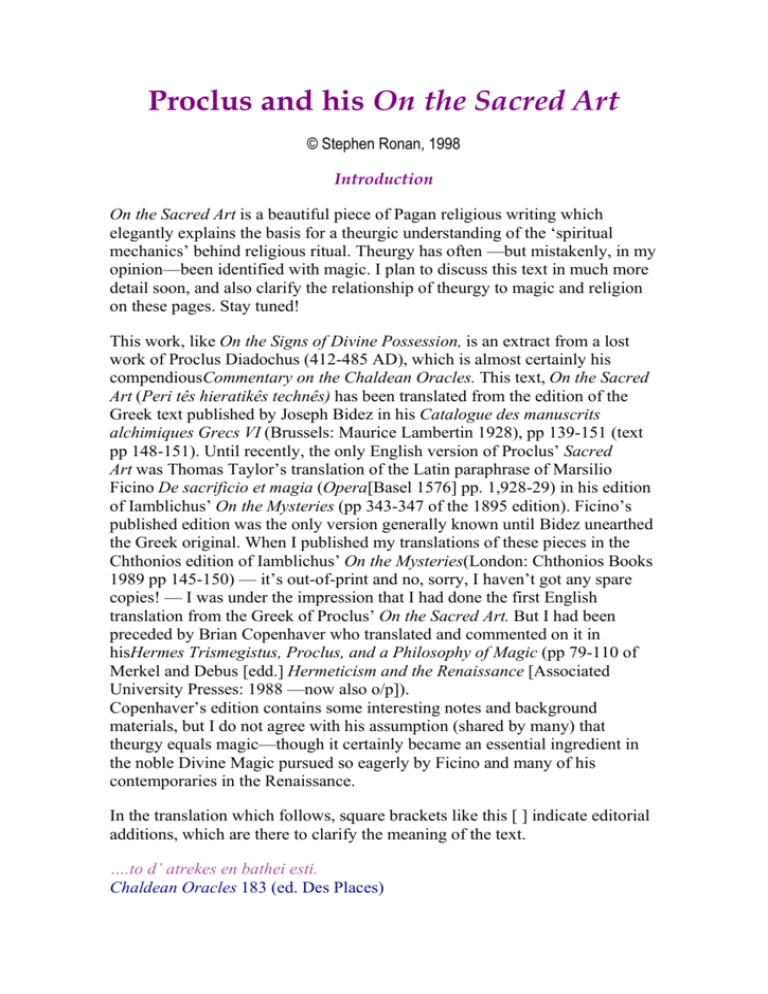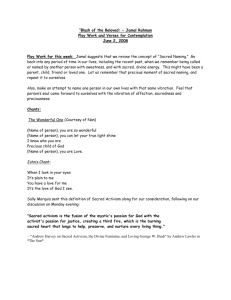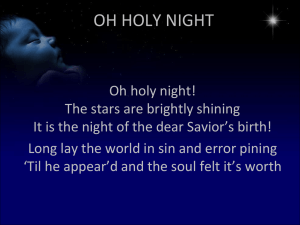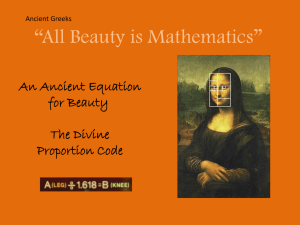Proclus and his On the Sacred Art
advertisement

Proclus and his On the Sacred Art © Stephen Ronan, 1998 Introduction On the Sacred Art is a beautiful piece of Pagan religious writing which elegantly explains the basis for a theurgic understanding of the ‘spiritual mechanics’ behind religious ritual. Theurgy has often —but mistakenly, in my opinion—been identified with magic. I plan to discuss this text in much more detail soon, and also clarify the relationship of theurgy to magic and religion on these pages. Stay tuned! This work, like On the Signs of Divine Possession, is an extract from a lost work of Proclus Diadochus (412-485 AD), which is almost certainly his compendiousCommentary on the Chaldean Oracles. This text, On the Sacred Art (Peri tês hieratikês technês) has been translated from the edition of the Greek text published by Joseph Bidez in his Catalogue des manuscrits alchimiques Grecs VI (Brussels: Maurice Lambertin 1928), pp 139-151 (text pp 148-151). Until recently, the only English version of Proclus’ Sacred Art was Thomas Taylor’s translation of the Latin paraphrase of Marsilio Ficino De sacrificio et magia (Opera[Basel 1576] pp. 1,928-29) in his edition of Iamblichus’ On the Mysteries (pp 343-347 of the 1895 edition). Ficino’s published edition was the only version generally known until Bidez unearthed the Greek original. When I published my translations of these pieces in the Chthonios edition of Iamblichus’ On the Mysteries(London: Chthonios Books 1989 pp 145-150) — it’s out-of-print and no, sorry, I haven’t got any spare copies! — I was under the impression that I had done the first English translation from the Greek of Proclus’ On the Sacred Art. But I had been preceded by Brian Copenhaver who translated and commented on it in hisHermes Trismegistus, Proclus, and a Philosophy of Magic (pp 79-110 of Merkel and Debus [edd.] Hermeticism and the Renaissance [Associated University Presses: 1988 —now also o/p]). Copenhaver’s edition contains some interesting notes and background materials, but I do not agree with his assumption (shared by many) that theurgy equals magic—though it certainly became an essential ingredient in the noble Divine Magic pursued so eagerly by Ficino and many of his contemporaries in the Renaissance. In the translation which follows, square brackets like this [ ] indicate editorial additions, which are there to clarify the meaning of the text. ….to d’ atrekes en bathei esti. Chaldean Oracles 183 (ed. Des Places) Stephen Ronan Hastings UK, September 1988 Proclus Diadochus ON THE SACRED ART (Bidez, p. 148) Just as [true] lovers move on beyond the beauty perceived through the senses until they reach the Sole Cause of all beauty and all perception (noêtôn), so too, the experts in sacred matters (hoi hieratikoi), starting with the Sympathy connecting visible things both to one another and to the Invisible Powers, and having understood that all things are to be found in all things, they established the Sacred Science (tên epistêmên tên hieratikên). They marvelled at seeing those things which come last in those which come first, and vice-versa; earthly things in the heavens in a causal and celestial manner, and heavenly things on the earth in a terrestrial way. How else could it be that the sunflower (hêliotropia) moves in accordance with the sun and the moonflower (selênotropia) with the moon, each, according to its ability, turning around with the luminaries of the world? For all things pray according to the rank they occupy and hymn the Leaders who preside over the whole of their ‘chains’ (tôn seirôn), either spiritually (noerôs), rationally, naturally (phusikôs) or in a sensory manner (aisthêtôs) So the sunflower moves with what makes it open as much as it can, and if one could hear how it makes the air vibrate (plêssontos) as it turns around, one would realise from the sound that it is making a hymn to its King, of the kind that a plant can sing. Thus there are to be seen on the earth suns and moons in a terrestrial form, and in the heavens all the plants, stones and animals after a celestial manner, alive in a spiritual way (zônta noerôs). Having contemplated these things, the wise men of old (hoi palai sophoi) brought together various things down here with their heavenly counterparts, and brought down Divine Powers into this mortal place, having drawn them down through Similarity (homoiotêtos): for Similarity is powerful (149) enough to attach beings to one another. For instance, if a wick which has been heated beforehand is placed under a lamp, not far from the flame, you will see it light up even though it has not touched the flame, for the transmission of the flame takes place downwards. By analogy, you may consider the heat already there in the wick to correspond to the Sympathy between things, and its being brought and placed below the flame to correspond to the Sacred Art (hieratikês technês) making use of material things at the right time and in the right way. The transmission of the flame is like the presence of the Divine Light with those who are able to partake of it, and the lighting up of the wick is analogous to both the deification of mortals and to the illumination of material substances, each thing then moves towards that which remains on high [i.e. its divine counterpart] according to its share of the Divine Seed, like the light of the wick once it has been lit. The lotus also demonstrates the workings of Sympathy. Its petals are closed before the appearance of the sun’s rays, but it gradually opens them as the sun begins to rise, unfolding them as it reaches its zenith and curling them up again as it descends. What then is the difference between the human manner of hymning the sun, by opening and closing the mouth and lips, and that of the lotus by opening and closing its petals? For those are its lips and that is its natural hymn (humnos phusikos). But why should we talk of plants where some trace of generative life still exists? For stones as well can be seen to be infused (empneontas) with the emanations of the luminaries, thus we see the rays of the sun reproduced in the golden rays of the sunstone (hêlitên). The stone called the Eye of Belos, which in form resembles the pupil of the eye, emits from the centre of its pupil a gleaming light which leads one to think that it ought to be called the Eye of the Sun. Moonstone (selênitên) changes both its markings and their motions [i.e. their patterns] along with the moon. Sunmoonstone (hêlioselênon) is just like an image of the conjunction (sunodou) of these two luminaries, portraying the conjunctions and separations which take place in the heavens. Thus all things are full of Gods. The earth is full of celestial Gods and the heavens are full of supercelestial Gods. Each ‘chain’ increases in number (p. 150) as it proceeds to its final terms, and the same qualities which are present in all the members of a ‘chain’ are there in the Unity preceding their manifestation. Thus we get the arrangement of [human] souls, some grouped around (sustaseis) one God, others around another. For instance, there happen to be a large number of solar animals, like the lion and the cock, who partake of the [solar] God, each according to their rank. The remarkable thing is that in this particular case, the bigger and stronger fears the lesser and weaker, for it is said that the lion shrinks back in fear at the sight of the cock. The reason for this is not be found in their physical qualities (aisthêseôs), but in spiritual (noeras) considerations: that is, the differences lie in the Causes themselves. At any rate, the presence of solar symbols is more effective in the cock. It clearly show this by its sensitivity (sunaisthanomenos) to the course of the sun, for it crows a hymn at sunrise and at the rest of the sun’s turning points. For the same reason, certain solar Angels are seen in forms of this kind [i.e. like cocks], for whilst these Angels are formless in reality, they appear by concealing themselves in form to us who have been endowed with form (memorphômenoi). Thus it is said that certain solar Daemons who appear with lion-faces, disappear at once when shown the image of a cock, retreating in fear from the superior Sigils [or Divine Signs sunthêmata]. In the same way, many people are held back from doing something wrong, simply just by seeing the images of divine men. To put it all plainly, some things move in accordance with the course of a luminary, like those plants we have spoken of. Others imitate the form of its rays, like the palm tree. Some again have an empyrean [or fiery] essence, like the laurel; and others imitate some other quality. From these things one can see that the properties which are contained in the sun in a concentrated form (sunespeiramenas) are to be found in a divided-up state amongst those entities who partake of the sun’s qualities: Angels, Daemons, [human] souls, animals, plants and stones. From these facts, the masters of the Sacred Art (hoi tês hieatikês hêgemones) found the way to pay divine honours [or service] to the Higher Powers, by following what lay in front of their eyes, and by mixing together some things and removing others, as appropriate. And when they made use of a mixture of things it was because they had observed that unmixed each thing has some quality of the God, but taken alone was not sufficient to invoke them. So by mixing together many different things they unified the emanations (aporrhoias) referred to previously [149, 20] and by the production of one thing from many, they made a likeness of that Whole which exists before every thing else comes into being. And so they often constructed images (agalmata) (p. 151) and incenses from these mixtures, mingling into one the divided Divine Sigils (sunthêmata), and making by art that which a God contains essentially (ousian). Thus they unified the multiplicity of powers which when dispersed are weakened, but when combined lead back up to the essential Form of its Archetype (tên tou paradeigmatos idean). Sometimes it happens that just a single herb or stone is sufficient in a ritual operation. So kneôron (flax-leaved daphne or spurge-flax) is sufficient for a manifestation (autophaneian) For protection, laurel (daphnê) or a thorny shrub (rhamnos), or the squill (skulla), or coral (kouraliou), or diamond (adamas) or jasper (iaspis). For knowledge of the future, the heart of a mole (hê tou asplakos kardia), and for purification, sulphur and seawater. Working in this way, the masters of the Sacred Art attracted some things through Sympathy and repelled others through Antipathy. For instance [as an example of antipathy], sulphur and bitumen (asphaltos) purify through the sharpness of their smell, and one sprinkles seawater because it partakes of the empyrean (or fiery) power And so in their Initiations [or Consecrations] and other Divine Ceremonies (tais teletais de kai tais allais peri tous theous therapeias) they would choose the appropriate animals and other materials. Longing to go beyond these and similar things [that is, they wanted to go beyond the powers inherent in physical objects], they came to know the Daemonic Powers which are essentially linked to the activities of nature and physical bodies, and by this means they drew down (epêgagonto) these Powers in order to communicate (sunousian) with them. From the Daemonic Powers they moved straight up towards the actual Doings of the Gods (autas…tas tôn theôn…poiêseis), instructed in some matters by the Gods themselves, but in others moved by their own efforts to an accurate conception of the appropriate symbols. And so, leaving nature and physical operations below, they came to directly experience (echrêsanto) the Primordial (prôtourgois) and Divine Powers. As I said, I plan to include more notes and background on this beautiful piece soon. In the meantime, check out the other pieces from ancient Neoplatonism available on this site. For books on the subject, check out the links below! Legal stuff Apart from downloading a copy for your own use, please do not reproduce or disseminate this document without written permission. © 1998 Stephen Ronan.










